

Kanta portreti. Print Von dieser Seite aus haben Sie Zugriff auf die digitalisierte Version der von Rudolf Malter angelegten umfassenden Sammlung von Kopien von Kant-Bildnissen, die wir im Gedenken an ihn vor dem Vergessen bewahren und einer interessierten Öffentlichkeit zeigen möchten.

Wählen Sie eine der links aufgeführten Kategorien und Sie gelangen zu einer entsprechenden Bilderliste. Von dort aus können Sie die Bilder betrachten, indem sie das jeweilige Vorschau-Icon anklicken. Das Bild wird daraufhin in einem eigenen Fenster geöffnet. Neben dem Thumbnail finden Sie eine kurze Beschreibung des Bildes und in einer weiteren Spalte in Form einer Nummer einen Verweis auf weiterführende Texte. Die Klassifizierung und Beschreibung des Materials wurde aus pragmatischen Gründen nach einfachen und äußerlichen Kriterien erstellt. Kant on the Web: Resources on Other Web Sites. Kant on the Web Kant Resources on Other Web Sites Other Internet Resources Biographies or General Introductory Essays Articles or Books on Kant Teaching/lecture information Articles or Books (discussing technical issues in Kant-scholarship) Click here for a separate listing of Steve Palmquist's articles and books.
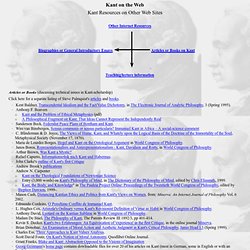
Kant: Idea for a Universal History from a Cosmopolitan Point of View. Immanuel Kant (1724-1804) Source: Idea for a Universal History from a Cosmopolitan Point of View (1784).
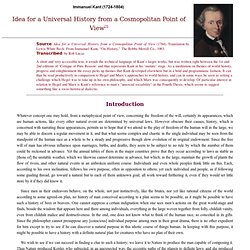
Translation by Lewis White Beck. From Immanuel Kant, “On History,” The Bobbs-Merrill Co., 1963.Transcribed: by Rob Lucas. Kant-norton. Critique. Critique is a method of disciplined, systematic analysis of a written or oral discourse.
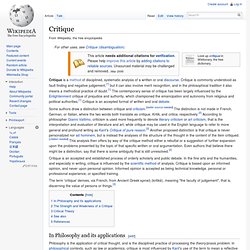
Critique is commonly understood as fault finding and negative judgement,[1] but it can also involve merit recognition, and in the philosophical tradition it also means a methodical practice of doubt.[1] The contemporary sense of critique has been largely influenced by the Enlightenment critique of prejudice and authority, which championed the emancipation and autonomy from religious and political authorities.[1] Critique is an accepted format of written and oral debate.
Some authors draw a distinction between critique and criticism. Critique is an accepted and established process of orderly scholarly and public debate. In the fine arts and the humanities, and especially in writing, critique is influenced by the scientific method of analysis. Kant's Aesthetics and Teleology. First published Sat Jul 2, 2005; substantive revision Wed Feb 13, 2013.
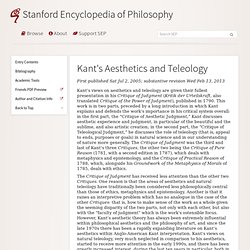
Kant and Hume on Morality. First published Wed Mar 26, 2008; substantive revision Sun Aug 12, 2012 The ethics of Immanuel Kant (1724–1804) is often contrasted with that of David Hume (1711–1776).
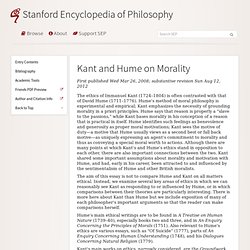
Hume's method of moral philosophy is experimental and empirical; Kant emphasizes the necessity of grounding morality in a priori principles. Hume says that reason is properly a “slave to the passions,” while Kant bases morality in his conception of a reason that is practical in itself. Hume identifies such feelings as benevolence and generosity as proper moral motivations; Kant sees the motive of duty—a motive that Hume usually views as a second best or fall back motive—as uniquely expressing an agent's commitment to morality and thus as conveying a special moral worth to actions.
Although there are many points at which Kant's and Hume's ethics stand in opposition to each other, there are also important connections between the two. Aesthetic Judgment. First published Fri Feb 28, 2003; substantive revision Thu Jul 22, 2010 Beauty is an important part of our lives.

Ugliness too. It is no surprise then that philosophers since antiquity have been interested in our experiences of and judgments about beauty and ugliness. They have tried to understand the nature of these experiences and judgments, and they have also wanted to know whether these experiences and judgments were legitimate. Both these projects took a sharpened form in the 20th century, when this part of our lives came under a sustained attack in both European and American intellectual circles. 1. Kant's Account of Reason. First published Fri Sep 12, 2008; substantive revision Tue Mar 18, 2014 Two of the most prominent questions in Kant's critical philosophy concern reason.

The first, central to his theoretical philosophy, is the unprovable pretensions of reason in earlier “rationalist” philosophers, especially Leibniz and Descartes. The second, central to his practical philosophy, is the subservient role accorded to reason by the British empiricists—above all Hume, who declared, “Reason is wholly inactive, and can never be the source of so active a principle as conscience, or a sense of morals” (Treatise, 3.1.1.11; see also the entry on rationalism vs. empiricism). Encyclopedia of Philosophy Online : Kant, Immanuel (1724-1804) Kant: Aesthetics Immanuel Kant is an 18th century German philosopher whose work initated dramatic changes in the fields of epistemology, metaphysics, ethics, aesthetics, and teleology.
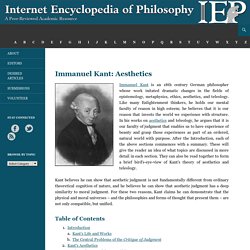
Like many Enlightenment thinkers, he holds our mental faculty of reason in high esteem; he believes that it is our reason that invests the world we experience with structure. In his works on aesthetics and teleology, he argues that it is our faculty of judgment that enables us to have experience of beauty and grasp those experiences as part of an ordered, natural world with purpose. After the Introduction, each of the above sections commences with a summary.
These will give the reader an idea of what topics are discussed in more detail in each section. Kant's Critique of Metaphysics. First published Sun Feb 29, 2004; substantive revision Tue Apr 10, 2012 How are synthetic a priori propositions possible?
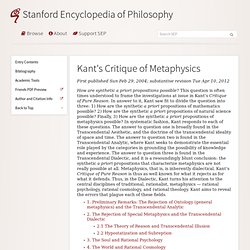
This question is often times understood to frame the investigations at issue in Kant's Critique of Pure Reason. In answer to it, Kant saw fit to divide the question into three: 1) How are the synthetic a priori propositions of mathematics possible? 2) How are the synthetic a priori propositions of natural science possible? Finally, 3) How are the synthetic a priori propositions of metaphysics possible? 1. Despite the fact that Kant devotes an entirely new section of the Critique to the branches of special metaphysics, his criticisms reiterate some of the claims already defended in both the Transcendental Aesthetic and the Transcendental Analytic. 2. Although this general charge is certainly a significant part of Kant's complaint, the story does not stop here. 2.1 The Theory of Reason and Transcendental Illusion 2.2 Hypostatization and Subreption 3.
Immanuel Kant Biography. Allan W. Kristiāns Helmuts Vencels: ievads Kanta estētikā.